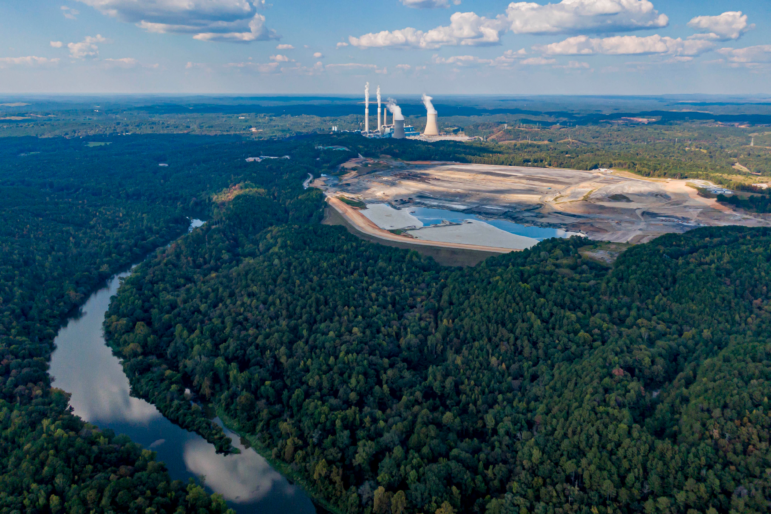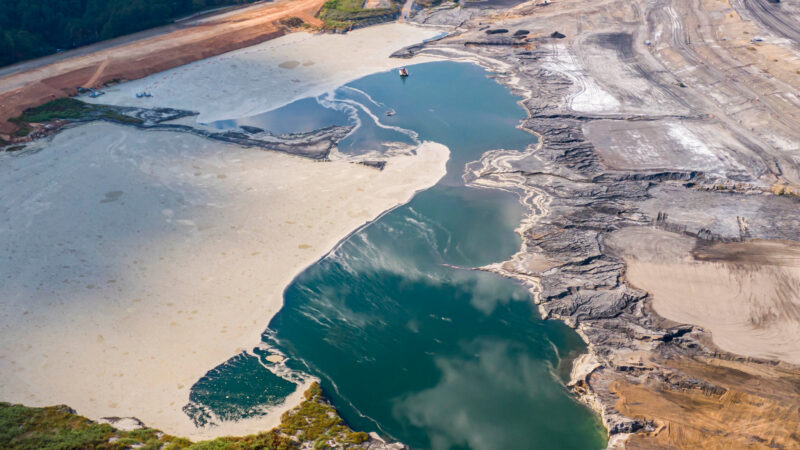EPA formally denies Alabama’s plan for coal ash waste
This article originally appeared on Inside Climate News, a nonprofit, independent news organization that covers climate, energy and the environment. It is republished with permission. Sign up for their newsletter here.
By Lee Hedgepeth, Inside Climate News
MOBILE, Ala.—The Environmental Protection Agency has formally denied Alabama’s plan to allow Alabama Power and other utilities to continue storing toxic coal ash in unlined pits at sites across the state.
The decision, formalized Thursday, is the culmination of months of back-and-forth between state and federal environmental regulators over coal ash storage sites.
Environmental organizations have applauded the denial, arguing that Alabama’s plans were not protective of citizens or the environment. In a statement issued after the EPA announced its decision, the Alabama Department of Environmental Management said it was disappointed and would appeal.
The state’s coal ash program “meets all the legal, environmental, and other requirements for approval. The program and the permits issued under the program are leading the way in protecting the public and the environment,” the ADEM statement said.
ADEM plans to appeal the EPA’s denial in federal court, the agency said.
Anthony Cook, an Alabama Power spokesperson, said in a statement that the utility is reviewing the EPA decision.
“We remain committed to complying with all environmental rules and regulations,” the statement said.
The EPA first announced a proposed denial of Alabama’s coal ash disposal plan last August, saying it did little to protect humans and the environment. The decision marked EPA’s first-ever denial of such a state plan.
“Exposure to coal ash can lead to serious health concerns like cancer if the ash isn’t managed appropriately,” EPA Administrator Michael S. Regan wrote in a statement at the time. “Low-income and underserved communities are especially vulnerable to coal ash in waterways, groundwater, drinking water, and in the air. This is why EPA works closely with states to ensure coal ash is disposed of safely, so that water sources remain free of this pollution and communities are protected from contamination.”

Regan had announced an enforcement crackdown on coal ash pollution in January 2022 after four years of effort by the Trump administration to relax coal ash regulations.
As of 2012, more than 470 coal-fired electric utilities in 47 states and Puerto Rico had already generated about 110 million tons of coal ash, one of the nation’s largest industrial waste streams, according to the EPA.
In 2015, the agency adopted a new Coal Ash Rule, providing a series of safe disposal requirements. But a 2019 report by the Environmental Integrity Project and other advocacy groups found that 91 percent of coal-fired plants still had ash landfills or waste ponds that leak highly toxic metals and chemicals such as arsenic, lead, mercury, selenium and cadmium into groundwater at dangerous levels, often threatening streams, rivers and drinking water aquifers.
Federal law now requires that closures of so-called coal combustion residual (CCR) units either comply with federal regulations or with state-adopted regulations that, at a minimum, are as protective of humans and the environment as the federal requirements.
So far, the EPA has approved three other states’ plans for CCR unit closure. But EPA officials, in reviewing Alabama’s plan, determined that it does not meet even those minimal requirements laid out in federal law regarding groundwater protection, monitoring and cleanup.
Coal ash, or CCR, is an umbrella term that refers to several waste materials generated by the process of burning coal for electricity production. These waste materials can include fly ash, bottom ash, boiler slag and flue gas desulfurization sludge.
Often, energy utilities combine these waste materials with water and store them in ponds at or near electrical generating plants, a practice environmental groups have criticized as risking groundwater contamination. Currently, Alabama has nine coal ash disposal sites across the state, most of which are located near waterways.
Such storage of hazardous materials isn’t always safe, history shows.
In 2008, more than a billion gallons of toxic coal ash spilled onto 300 acres of nearby land when a dike holding the waste in a pond collapsed in Tennessee. Dozens of cleanup workers died of illnesses allegedly caused by exposure to the toxic ash during the cleanup and hundreds remain ill years later, according to a report by Earthjustice.
In 2014, a steel sewer line under a North Carolina coal ash pond collapsed, allowing the waste material to flow into the pipe and, eventually, into the nearby Dan River, polluting the water and putting dozens of marine species in harm’s way. The disaster was among more than 160 cases of water contamination at coal ash sites that spurred adoption of the Coal Ash Rule in 2015.
Energy companies generally have two options when deciding how to manage coal ash waste. “Capping” coal ash in place, the cheaper method of CCR unit closure, involves removing the water from a coal ash pond and placing a synthetic liner over the remaining waste to prevent access by rainwater. Environmental groups say this method is inferior to so-called “clean closure,” where utilities entirely remove the ash from the impoundment to a lined landfill or for beneficial reuse in products like concrete.

An executive of Alabama Power, which owns most of the state’s CCR units, claimed at a September 2023 EPA hearing that the utility’s storage ponds are “structurally sound.” Susan Comensky, Alabama Power’s vice president of environmental affairs, told EPA officials that allowing the company to “cap” CCR waste in place, even in unlined pits, will not present significant risks to human or environmental health.
“Even today, before closure is complete, we know of no impact to any source of drinking water at or around any Alabama Power ash pond,” Comensky said at the time.
However, Alabama Power has been repeatedly fined for leaking coal ash waste into groundwater.
In 2019, ADEM fined the utility $250,000 after groundwater monitoring at a disposal site on the Coosa River in Gadsden showed elevated levels of arsenic and radium, according to regulatory documents.
In 2018, ADEM fined five of Alabama Powers plants a total of $1.25 million for groundwater contamination, records show. In its order issuing the fine, the agency cited the utility’s own groundwater testing data, which showed elevated levels of arsenic, lead, selenium and beryllium.
In its formal denial, EPA officials wrote that Alabama’s plan did not adequately protect the state’s groundwater from contamination by coal ash residuals following “cap-in-place” closure.
“Under federal regulations, coal ash units cannot be closed in a way that allows coal ash to continue to spread contamination in groundwater after closure. In contrast, Alabama’s permit program does not require that groundwater contamination be adequately addressed during the closure of these coal ash units,” the decision said. “Specifically, EPA identified deficiencies in Alabama’s permits with closure requirements for unlined surface impoundments, groundwater monitoring networks, and corrective action (i.e., investigation and clean up) requirements.”
EPA discussed these issues with the Alabama Department of Environmental Management, the federal regulator said, but “the state agency has not revised its permits or supplemented its application to demonstrate how such permits are as protective as the federal requirements.”
As part of its formal denial, EPA officials responded to multiple criticisms by ADEM officials. In its comments on the proposed denial of its CCR plan, ADEM wrote that the EPA ignored facts, dismissed the opinions of the state agency’s professional engineers and geologists and did not conduct a detailed review of facility files or background information used by ADEM to issue its CCR permits.
EPA officials challenged those arguments, writing in response that the federal agency had done its due diligence while Alabama had not.
“EPA did do a thorough review of the portions of the permits discussed in the proposal,” the agency wrote, in part. “EPA found that the permits were neither consistent with, nor as protective as the Federal CCR regulations with respect to all three areas reviewed.”
EPA officials also said that agency staffers have the technical expertise to independently assess whether permit requirements meet federal standards, leaving no need to rely on state agency experts.
“EPA must follow the facts,” the agency wrote. “This demands that the Agency conduct its own evaluation and reach its own conclusions, and not uncritically adopt…assessments from other parties. This is the case regardless of those individuals’ own professionalism. To do otherwise for fear of causing offense, would be to abrogate the Agency’s oversight role.”
Representatives of the Southern Environmental Law Center praised Thursday’s decision.
“The people of Alabama are emphatic. They do not want this toxic waste threatening their communities and waterways,” said Barry Brock, director of SELC’s Alabama office. “EPA hears Alabama citizens and is standing up to monopoly utilities like Alabama Power.”
Since the EPA announced its planned denial last August, thousands of comments poured into the agency. Comments submitted by individual Alabamians overwhelmingly supported the EPA’s decision to deny Alabama’s plan, according to a review of relevant documents by Inside Climate News. Comments opposed to the EPA’s decision were most commonly submitted by utilities or industry associations.
“Today marks a significant victory for every Alabamian who values clean water,” said Cade Kistler of Mobile Baykeeper, an environmental nonprofit that has challenged coal ash plans in court. “The EPA’s final denial underscores what our communities have said all along — that leaving toxic coal ash in unlined, leaking pits by our rivers is unacceptable. Alabama must adopt a protective permitting program that keeps communities safe by ensuring that utilities properly deal with coal ash, not allowing them to abandon it on our riverbanks.”
Even in their denial, EPA officials signaled a willingness to work with Alabama in drafting and implementing an acceptable state-level plan for coal ash storage.
“EPA is laser-focused on protecting people from exposure to pollution, like coal ash, that can cause cancer risks and other serious health issues,” said Regan. “Our job is to work closely with states to make sure that every community is protected from contamination, and that’s especially true for those that have been overburdened by pollution for too long. EPA stands ready to continue working with Alabama so that they can submit an approvable application and implement a program that is as protective of public health as the federal standards.”
Alabama prison chief responds to families’ criticism
The department said that a number of changes have been made since Corrections Commissioner John Q. Hamm was appointed in 2022. The department said hiring has increased, and there are ongoing efforts to curb the flow of contraband and improve communications with families.
40 years after ‘Purple Rain,’ Prince’s band remembers how the movie came together
Before social media, the film Purple Rain gave audiences a peak into Prince’s musical life. Band members say the true genesis of the title song was much less combative than the version presented in the film.
Park Fire in California could continue growing exponentially, Cal Fire officer says
Cal Fire has confirmed that over a hundred structures have been damaged in the Park Fire, which grew overnight near Chico, Calif. Difficult firefighting conditions are forecast through Friday night.
Checking in with Black voters in Georgia about the election, now that Biden is out
Some voters who could be key to deciding who wins Georgia. What do they think about Vice President Harris becoming the frontrunner in the race to be the Democratic nominee?
Tahiti’s waves are a matter of ‘life and death’ for surfing Olympics
Tahiti's Teahupo'o wave has a slew of riders for the Paris 2024 Olympics. NPR finds out why it's called one of the most dangerous waves.
Researchers are revising botanical names to address troubling connotations
Since the mid-1700s, researchers have classified life with scientific names. But some of them have problematic histories and connotations. The botanical community is trying to tackle this issue.




